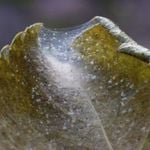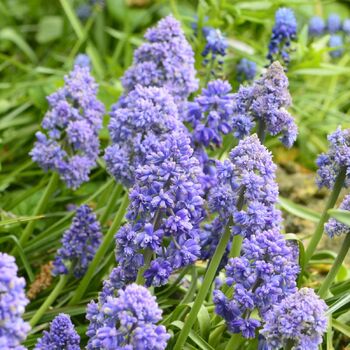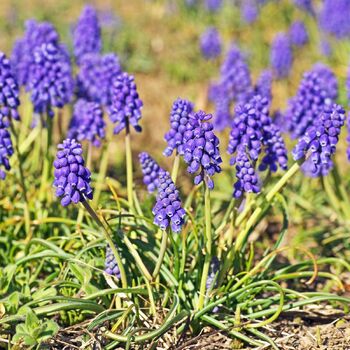
How to Grow Muscari Bulbs
Grow Guide #2604
Family: Liliaceae
Binomial name: Muscari armeniacum
Life Cycle: Perennial
This 'How to Grow' guide details everything a home gardener needs to know to plant, grow and care for Muscari (Muscari armeniacum).
When to Plant Muscari Bulbs
Use the table below to identify the best time of year to plant muscari bulbs in your climate.
| JAN | FEB | MAR | APR | MAY | JUN | JUL | AUG | SEP | OCT | NOV | DEC | |
|---|---|---|---|---|---|---|---|---|---|---|---|---|
| Cool | ||||||||||||
| Temperate | ||||||||||||
| Sub-Tropical | ||||||||||||
| Tropical | ||||||||||||
| Arid |
Preparation
Muscari plants are best grown in full sun or part shade. Choose a location that will receive at least 3 hours of full sun each day. They grow particularly well under deciduous trees where they are in dappled shade in summer and full sun in winter.
Muscari plants can be difficult to eradicate once they are established in the garden. Choose a permanent position in a garden bed or grow them in containers to prevent them spreading into unwanted areas.
Muscari plants need a loose, well drained soil enriched with organic matter. Prepare soil by weeding it thoroughly, digging it over to at least a spade’s depth to loosen the soil, and adding aged animal manure or compost. Organic matter can be dug into heavy soil to lighten it so roots can grow freely. Keep the area free of weeds until planting. Learn more about preparing soil for planting here.
Muscari plants can be grown in containers. If possible choose a variety that’s recommended for container growing. Use a good quality potting mix and make sure your container is large enough for mature plants; a minimum of 10 litres is recommended for muscari. During the growing season, keep in mind that container grown plants may need additional fertiliser to encourage healthy growth.
How to Plant Muscari Bulbs
Muscari bulbs should be planted directly in their final position in the garden or a container.
- Plant individual bulbs 5-8cm apart and 5cm deep with the pointed tip facing upwards.
- Cover with soil and water in well.
- Keep soil moist but not wet until shoots emerge.
How to Grow Muscari
Muscari plants may need watering during the growing season. Water when the soil is dry about 5cm below the surface (test this by scratching away a little soil with your finger). Water deeply in the early morning or late afternoon. Avoid watering the leaves of plants to avoid fungal diseases. Learn more about watering here.
If soil was well prepared no extra fertiliser should be necessary. In poor soil or to give your plants an extra boost, application of a high-potassium fertiliser or one formulated for flowering plants can be beneficial:
- Apply slow release fertiliser at the recommended rate when transplanting or when seedlings are 5-10cm tall.
- Apply liquid fertiliser at the recommended rate and frequency while plants are fruiting or flowering.
Muscari plants should flower in approximately 90-120 days.
If growing muscari for cut flowers, use sharp snips or secateurs to cut the longest stems possible, removing the lower leaves and placing the stems immediately in a clean bucket of water. Learn more about cutting and conditioning homegrown flowers here.
Leave foliage to die down naturally after flowering; the bulb will absorb the nutrients in the leaves and use them to form the flowers for next season. Once all foliage has died down use sharp secateurs or snips to cut individual leaves at ground level.
Muscari bulbs can remain in the ground for several years without the need to lift and divide them. Mulch heavily to protect bulbs from very hot temperatures over summer. Bulbs can be lifted in areas that experience wet summers, if they become overcrowded or to move them to a different location in the garden.
Common Problems when Growing Muscari
Like all plants, muscari is susceptible to some pests, diseases and other problems. Below is a list of the most common problems gardeners encounter when growing muscari plants:
 Aphids are small (2-4mm long) sap-sucking insects that congregate on the new shoots or the undersides of leaves. They can cause leaves to wilt or become discoloured, and also excrete honeydew which can attract ants and other insect pests. To manage aphids, remove them by spraying with a garden hose, apply a soap or alcohol spray, or encourage predatory insects to your garden. Read more about aphids here.
Aphids are small (2-4mm long) sap-sucking insects that congregate on the new shoots or the undersides of leaves. They can cause leaves to wilt or become discoloured, and also excrete honeydew which can attract ants and other insect pests. To manage aphids, remove them by spraying with a garden hose, apply a soap or alcohol spray, or encourage predatory insects to your garden. Read more about aphids here..jpg) Rotten bulbs or corms are caused by pathogens entering bulbs or corms after sitting in cold, wet soil, being temporarily waterlogged or being exposed to warm temperatures in winter. They may show obvious signs of rot, have no roots or shoots, or produce stunted yellow leaves but no flowers. Plant bulbs and corms in free-draining soil, raised garden beds or containers; do not water while dormant; and lift and store them if recommended for your climate.
Rotten bulbs or corms are caused by pathogens entering bulbs or corms after sitting in cold, wet soil, being temporarily waterlogged or being exposed to warm temperatures in winter. They may show obvious signs of rot, have no roots or shoots, or produce stunted yellow leaves but no flowers. Plant bulbs and corms in free-draining soil, raised garden beds or containers; do not water while dormant; and lift and store them if recommended for your climate. Spider mites (Tetranychus urticae), also known as two spotted mites, are sap-sucking arachnids that cause dry, wilted or discoloured leaves. The undersides of leaves may feel dry and a little like fine sandpaper. Prune plants to allow good air flow or spray with eco-oil or wettable sulphur. Learn more about managing spider mites here.
Spider mites (Tetranychus urticae), also known as two spotted mites, are sap-sucking arachnids that cause dry, wilted or discoloured leaves. The undersides of leaves may feel dry and a little like fine sandpaper. Prune plants to allow good air flow or spray with eco-oil or wettable sulphur. Learn more about managing spider mites here.


.png)




